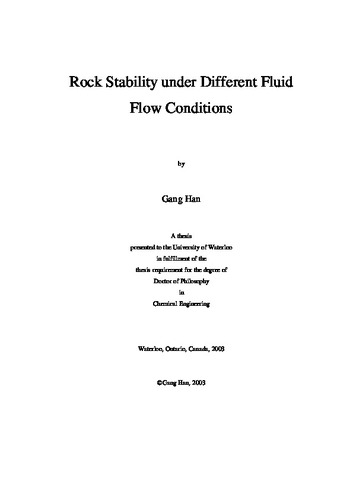| dc.description.abstract | It is widely known in oil industry that changes in fluid flow conditions such as water breakthrough or unsteady flow due to well shut-in can lead to sand destabilization, with a possible consequent sand production. In this research, different flow situations are incorporated into stress and stability analysis for the region around a wellbore producing oil from weak or unconsolidated sands, and the analyses involve strength weakening, stress redistribution, and decrease of rock stiffness.
Two main mechanisms, chemical reactions of rock with formation water and variations of rock capillary strength, are identified and analyzed to study strength weakening after water breakthrough, both qualitatively and quantitatively. Using theories from particle mechanics, rock mechanics, and interfacial science, four novel capillarity models are developed and verified to analytically capture the physical behaviors of capillary strength at the grain scale. Based on model calculations, significantly better understanding of strength behavior in two-phase fluid environments is achieved.
Based on a simplified model that can conservatively but efficiently quantify capillary strength with only two input parameters (i. e. particle radius and water saturation), a verified new method that physically calculates pore pressure in a multiphase environment, and a coupled poro-inelastic stress model, the redistributions of effective stresses with water saturation around a wellbore are solved. In terms of stress changes and growth of a plastic radius defining shear-failure zone, the effects of different stability factors, including capillarity through water-oil menisci, pore pressure changes due to the variations of fluid relative permeabilities, and loss of strength through chemical reactions of water-sensitive cementation materials, are quantified and compared in order to clarify when and how they contribute to sand production after water breakthrough.
The nonlinearities of rock elastic properties in stressed and biphasic fluid environments is analytically addressed, based on an improved nonlinear theory that considers both a failure-based mechanism and a confining-stress-based mechanism, the strength model, and the coupled stress model. The calculations demonstrate the redistributions of stress-dependent rock stiffness around a wellbore and its evolution with increase of water saturation, clarify the relative importance of each mechanism in reducing rock stiffness, and fundamentally explain why current predictive technologies are invalid when water appears in a flowing wellbore.
To quantify the effect of well shut-down on rock stability, the redistributions of fluid pressure in reservoir are analytically solved and coupled with the stress model, while the water hammer equations provide a boundary condition for the bottom-hole pressure. This approach allows direct solution of the relationships among fluid properties, rock properties and production parameters, within the context of rock stability.
The proposed new approaches and models can be applied to evaluate sand production risk in multiphase and unsteady fluid flow environment. They can also serve as points of departure to develop more sophisticated models, or to develop more useful constitutive laws for numerical solutions. | en |

